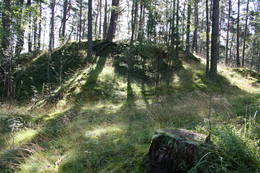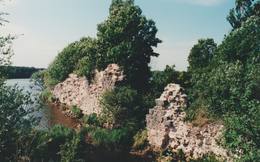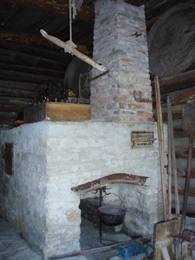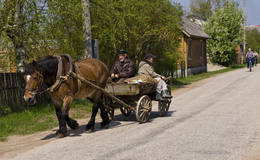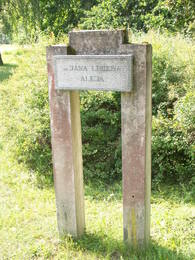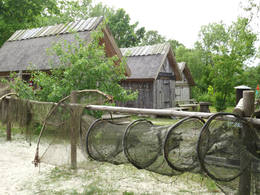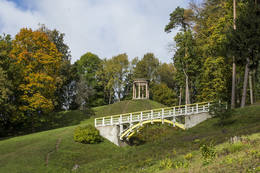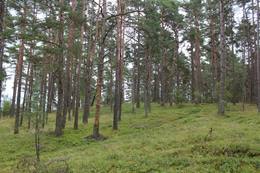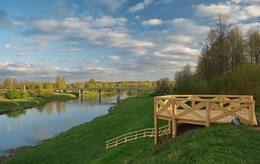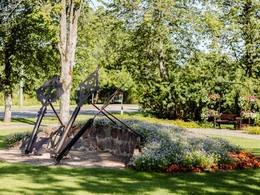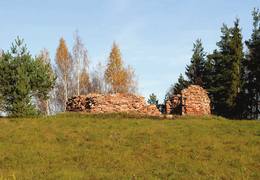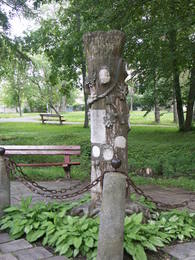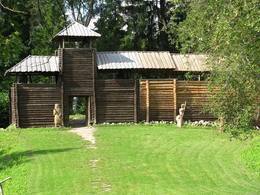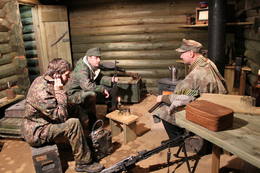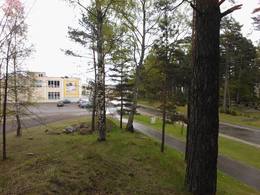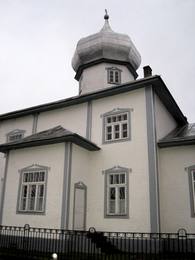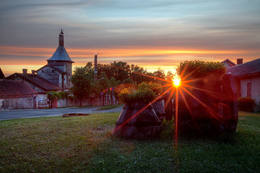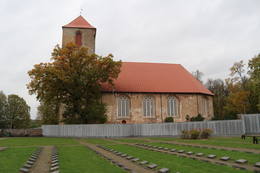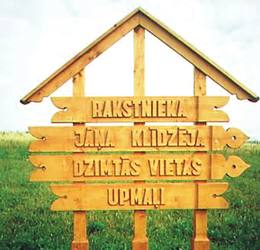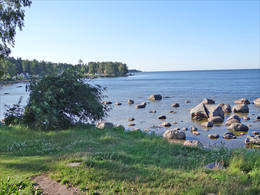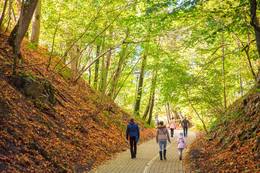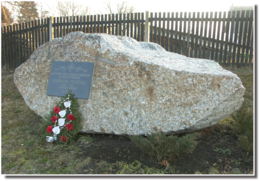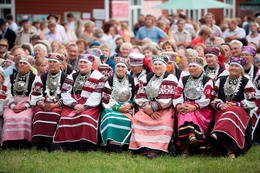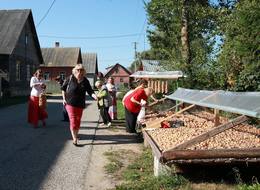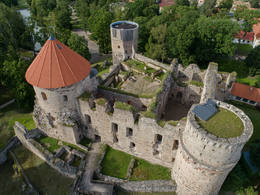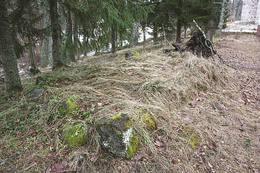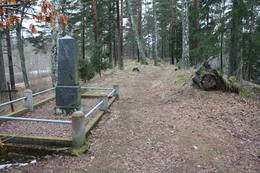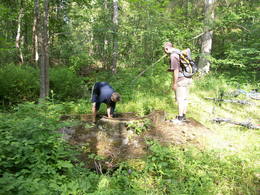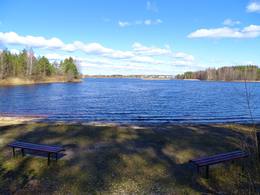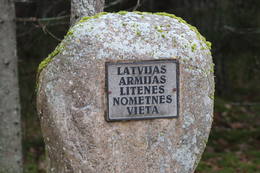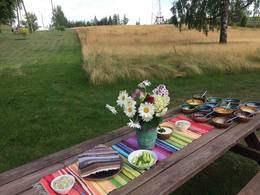Senās vēsturiskās vietas
| Pārskats | Detaļas |
|---|---|
|
Latvija
Āraišu ezerpilsĀraišu ezerpils ir Eiropas mērogā nozīmīga 9. - 10. gs. seno latgaļu nocietinātas dzīvesvietas rekonstrukcija. Āraišu Arheoloģisko parku iespējams apmeklēt gan individuāli, gan grupās. Tiek piedāvātas ekskursijas gida pavadībā, dažādas izglītojošas nodarbības, kā arī programma jaunlaulātajiem. Tāpat tiek rīkoti dažādi tematiski pasākumi un amatu demonstrācijas. Parkā izveidots arī apmeklētāju centrs, kurā skatāma pastāvīga ekspozīcija. Tajā izzinošā veidā pirmo reizi kopš izrakumu veikšanas ir iespējams iepazīties ar tajos iegūtajām oriģinālajām liecībām, kā arī ar Jāņa Apala dzīves un ezerpils pētniecības stāstu. |
|
|
Latvija
Liepājas Pētera I namiņšAtrodas Kungu ielā 24. Viena no vecākajām pilsētas ēkām – koka guļbūve ar kārniņu jumtu, kascelta 17. gs. otrajā pusē un tautā iesaukta par Madam Hoijeres viesnīcu. Piemiņas plāksne uz ēkas sienas vēsta, ka 1697. g. “Lielās sūtniecības” ceļojuma laikā uz Rietumeiropu te bija apmeties (inkognito) Krievijas cars Pēteris I. Izvēle bijusi praktiska, jo šajā viesnīcā tualete atradusies iekštelpās. Ēka Kungu ielā 26 ir otra vecākā Liepājas dzīvojamā ēka, kas celta 1699. g. kā pilsētas birģermeistara dzīvojamā māja. Ziemeļu kara laikā šeit apmeties Zviedrijas karalis Kārlis XII. Abas ēkas ir apskatāmas tikai no ārpuses. |
|
|
Latvija
Dignājas pilskalnsViens no salīdzinoši nedaudzajiem Daugavas krastu pilskalniem, kas nav apaudzis ar kokiem un krūmiem, tādēļ apkaimes ainavā labi izceļas tā klasiskā pilskalna forma. Dignājas pilskalns bijis apdzīvots vairākos periodos, bet savu uzplaukumu sasniedza laikā no 5. līdz 9. gs., kad šajā vietā atradās nozīmīgs centrs. Atradumi liecina, ka Dignājas pilskalnā mājoja latgaļu ciltis. Pēc krustnešu invāzijas, pilskalnā uzcēla ordeņa pili, kas līdz mūsdienām nav saglabājusies. Saglabājušies nostāsti, ka zem pilskalna bijusi pazemes eja. No pilskalna paveras skaista ainava uz Daugavas ieleju. Pilskalnā saglabājušies 1. pasaules kara laika ierakumi. Tā piekājē atradusies apmetne. |
|
|
Latvija
Tromeļa pilskalnsVēl netālu no Kilmiņupes ietekas jūrā atrodas nostāstiem apvītais Tromeļa pilskalns – viduslaiku nocietinājuma vieta. Tā meklējama ap 100 m attālumā no „Krauju” mājām. Šeit 1977. gadā veiktajos arheoloģiskajos izrakumos atrastās ķieģeļu un krāsns podiņu lauskas liecina, ka nocietinājums izmantots viduslaikos. Vieta saistīta ar nostāstiem par jūras laupītāju Trommeli, kurš te esot noracis salaupītās bagātības, tāpēc kāpā redzamas daudzas mantraču saraktās bedres. Teika stāsta par jūras laupītāju Trommeli, kurš ar saviem ļaudīm aplaupījis kuģus Rīgas jūras līcī no Kurzemes piekrastes līdz Roņu salai. Senatnē šajā piekrastē noenkurojušies daudzi kuģi, kas gaidījuši labvēlīgāku ceļa vēju, lai varētu apbraukt Kolkas ragu, taču jūras laupītājs to izmantoja savtīgiem nolūkiem. Tas arī savācis bojā gājušo kuģu mantas. Trommeļa pils esot bijusi celta no mūra. (Avots: Rojas TIC) |
|
|
Latvija
Sēlpils pilskalnsMūsdienās – sala Pļaviņu HES ūdenskrātuvē, kurai var piekļūt ar laivu. Sens sēļu pilskalns, kas bijis apdzīvots vairakkārt laikā no 6. - 12. gadsimtam. Šeit atradās Sēlijas novada politiski - militārais centrs. 1373. g. līdzīgi kā daudzos citos senču pilskalnos Livonijas ordenis uzcēla mūra pili, ko nopostīja 1704. gadā - Ziemeļu kara laikā. Līdz mūsdienām ir saglabājušās četrstūrveida torņa atliekas, sardzes telpa un 12 m augsts priekšpils uzbērums. Apmēram 0,3 km ziemeļos no Sēlpils pilskalna redzams applūdinātais Oliņkalns. |
|
|
Igaunija
Kolski un Kobasāre (Koobasaare)Divas mazas apdzīvotas vietas nacionālā parka dienvidrietumu daļā. No kādreiz piecām Kolski ciema saimniecībām līdz mūsdienām ir saglabājusies tikai viena. Kolski iedzīvotājus līdzīgi kā citviet Baltijas valstīs pēc 2. pasaules kara deportēja uz Sibīriju. Kolski apkārtnē redzamie mājdzīvnieki „apsaimnieko” šejienes pļavas, neļaujot tām aizaugt ar mežu. Tādējādi tiek uzturēta apkaimes vēsturiskā ainava. 3 km dienvidrietumos meklējams Kobasāres ciems. Tā nosaukums (koopa no igauņu valodas nozīmē ala, saar – sala) atgādina par Ziemeļu kara notikumiem, kura laikā cilvēki slēpušies pašu raktās alās. Kobasārē un tam blakus esošajā Apjas (Apja) ciemā var izbaudīt patiesi 21. gadsimtam nepierastas lauku ainavas. |
|
|
Latvija
Gausā jūdzeAp 6 km garš un vienmuļš ceļa posms starp Ragaciemu un Klapkalnciemu, kur pēc nostāstiem senos laikos ceļiniekiem mēdza uzbrukt laupītāji. Apmēram 1,5 km pirms Klapkalnciema (dodoties no Ragaciema puses) kāpā pie jūras atrodas Somu jēgeru kaujām veltīts piemiņas akmens. To atklāja 1997. g. 9. decembrī. Akmens „atceļojis” no Somijas dienvidaustrumu daļas, kur 1940. g. tas kalpojis kā prettanku nocietinājums. Piemineklī ir iegravēts teksts: „Šeit 1. pasaules kara laikā, no 1916. gada augusta līdz decembrim cīnījās somu jēgeri”. Savukārt, Klapkalnciemā uzstādīts piemiņas akmens, kur apglabāti pieci somu karavīri. |
|
|
Igaunija
Valjala nocietinātā apmetneViens no iespaidīgākajiem Igaunijas salu pilskalniem, ko ieskauj no akmeņiem veidoti vaļņi. Livonijas Indriķa hronikā minēta kā salinieku vislabāk nocietinātā apmetne. |
|
|
Latvija
Smārdes krogsSmārdes krogs kādreizējā vēsturiskā kroga
vietā ar maltītes ieturēšanas iespējām. Ap 100 m
austrumos no kroga 2. Pasaules kara laikā
kritušo karavīru brāļu kapi un piemineklis.
|
|
|
Igaunija
Metsanurmes apmeklētāju centrsMetsanurmes apmeklētāju centrā jūs varat apskatīt veco graudu kulšanas ēku un veclaicīgus darba instrumentus. Intereses vērta ir arī ārā izstāde, kurā eksponēti vēsturiski lauku darbu rīki. Viss, kas šeit atrodas, ir veidots tā, lai ieinteresētu gan vietējos, gan tūristus. |
|
|
Latvija
Brāļu kapiBrāļu kapi Rīgas – Ventspils autoceļa (A 10)
malā. Koka laipa aizved līdz piemiņas akmenim,
kas veltīts 1. Pasaules kara laikā kritušajiem
|
|
|
Latvija
Interesantākās ēkas un saimniecībasVāldamō - dzīvojamā ēka ar dzeltenu krāsojumu un dabisku jumta materiālu, kas celta pagājušā gadsimta sākumā kā jaunsaimniecība. Virgo - nākamā (ziemeļos) saimniecība aiz Valdamo. Celta kā jaunsaimniecība pagājušā gadsimta divdesmitajos gados. Dzīvojamai ēkai (1930. g.) interesanti kokgriezumi. Fīlmaņi - nākamā (ziemeļos) aiz Virgo. Senatnīgā izskata ēka celta 20 gs. sākumā kā mazistaba. Silkalnus atrodam, ja ceļa krustojumā pagriežamies pa labi – Pitraga virzienā. Tā ir dzeltena krāsojuma ēka, kas celta ap 1906. g. kā mazistaba. Norpiedagi – atrodas dienvidos aiz Silkalniem. Brūna krāsojuma un lielāka izmēra kā iepriekšējā. Dzīvojamo ēku ap 1906. g. kā mazistabas klēti cēlis aktīvs lībiešu sabiedriskais darbinieks un laivu būvētājs Didriķis Volganskis (1884. – 1968.). 1912. g. šeit dzimis viņa dēls Edgars Valgamā, kas arī bija lībiešu kultūras darbinieks un strādājis par mācītāju Somijā. Anduļi atrodas pie iepriekš minētā ceļu krustojuma. Viena no lielākajām ciema vecsaimniecībām un arī ciema vecākā sēta, kuras vēsture zināma no 1680. gada, kad to sauca par Kūkiņiem. Tajā ietilpst dzīvojamā māja (~ 1909. g.), rija (1905. g.), klēts (19. gs. vidus) un dūmnams, kas uzsliets no pārzāģētas laivas. Zem Anduļu rijas daļas, kas celta kāpas mugurā, atrodas viduslaiku - t.s. Mēra kapi . Žoki – iepretim Anduļiem un otrpus ceļam. Pašreiz redzamā ēka būvēta uz vēsturiskās vecsaimniecības pamatiem. 19. gs. vidū Žokos atradās pirmā lasītmācīšanas skola lībiešu bērniem toreizējos Dundagas jūrmalciemos, kur par skolotāju strādāja lībietis Nika Polmanis (1823. - 1903.). Tilmači - nākamā (ziemeļos) saimniecība aiz Žokiem. Saglabājušās vairākas ēkas, kas tapušas 19. – 20. gs. mijā: brūna krāsojuma dzīvojamā ēka, stallis un klēts daļa. Veicot dzīvojamās ēkas restaurāciju, saimnieks ir atradis dēli ar uzrakstu „1825. Kurļandskaja guberņa". Iepriekš minētās septiņas vēsturiskās saimniecības un ēkas savulaik kandidēja uz iekļūšanu UNESCO pasaules kultūras mantojuma sarakstā. |
|
|
Latvija
Kurzemes un Vidzemes robežakmensVēsturiskais akmens, kurā redzama pirms vairāk nekā 200 gadiem iegrebtā robežzīme, norāda uz bijušo robežas vietu starp Kurzemes hercogisti un Krievijas guberņu. Mūsdienās tas iezīmē Babītes un Jelgavas novada robežu. Akmens meklējams austrumos no Kalnciema – Kūdras ceļa (dienvidos no Labā purva) meža stigas malā un nezinātājam var būt grūti atrodams. Šajā nolūkā noderēs ceļa apraksts: Ap 400 m dienvidos no auto stāvlaukuma pie Liliju ezera no Kalnciema – Kūdras ceļa pa labi (austrumos) nogriežas meža ceļš, kas noved lejā no Krāču kalniem. Pa to jādodas ap 170 m tālāk, līdz tas strauji pagriežas pa labi (uz dienvidaustrumiem). Tad jādodas minētajā virzienā, līdz pēc ~ 0,5 km jāpagriežas uz ziemeļaustrumiem, kur vēl pēc ~ 0,4 km kārtējā meža ceļu krustojumā jāpagriežas uz ziemeļiem. Pēc ~ 0,4 km jānogriežas pa labi (uz austrumiem) uz lielas stigas, kuras kreisajā (ziemeļu) pusē aiz meliorācijas grāvja bezlapu periodā jau redzams apaļīgais akmens stāvs. Līdz akmenim ceļu sliktā stāvokļa dēļ var nokļūt tikai ar kājām. |
|
|
Igaunija
Mūksi pilskalns (Muuksi linnamagi)Viens no Harju apriņķa (Harjumaa) lielākajiem pilskalniem, kas atrodas uz dabiskas Ziemeļigaunijas glinta pacēluma daļas. Pastāv dažādas versijas par tā izmantošanas veidiem un laiku, kurā tas noticis. Saglabājušies arī nostāsti, ka šeit tāpat kā Kolkasragā laupītāji ir kurinājuši viltus ugunskurus, lai garām braucošos kuģus izvilinātu seklumā. No Mūksi pilskalna paveras skats uz Kolgas līci (Kolga laht). Tā augšdaļā ir novietota metāla plāksne ar shematisku Igaunijas pilskalnu karti un trīsdaļīgs granīta piemineklis (uzstādīts 1994. g.), kas veltīts Igaunijas brīvības cīņu un 2. pasaules kara laika dalībnieku un ar tiem saistīto notikumu piemiņai. |
|
|
Lietuva
Etnogrāfiskie ciemiSalos, Vaišnoriškė, Strazdai, Šuminai – Augštaitijas nacionālā parka ciemi, kuros saglabājušas vēsturiskas viensētas ar koka ēkām un to plānojumu. Apdzīvoti. |
|
|
Latvija
Ķemeru pasta ēkaCelta pirmās Latvijas brīvvalsts laikā. Meklējama Tukuma ielā 30. Laikā no 1940. gada pastā darbojās automātiskā telefonu centrāle. Pasts vairs nestrādā un ēka apskatāma no ārpuses. |
|
|
Latvija
Stafenhāgena namsAtrodas Baznīcas ielā 17. Mūsdienās redzamo ēku cēla 17. gs. kā Kuldīgas birģermeistara dzīvojamo māju. 1701. gadā tajā uzturējies Zviedrijas karalis Kārlis XII, kurš tās priekštelpā atstāja lielu lādi (2 x 2,5 m), kas pēc restaurācijas joprojām ir brīvi apskatāma. Kā to izdarīt? Jāatver durvis un jāieiet priekšnamā, kur lāde redzama no abām pusēm. Tā kalpojusi kā karaļa apģērba glabāšanas vieta. |
|
|
Igaunija
Vienas ielas ciemi Raja-Kikita-Tiheda-Kasepē17. un 18. gadsimtā Peipusa ezera rietumu krastā ieradās Krievijas valdības vajātie vecticībnieki, kuru kopienai bija raksturīga apmešanās gar vienu, kilometriem garu ielu. Kasepē, Tihedas, Kikitas un Raja ciemi, kas sarindojušies gar Peipusa krastmalu līdz pat Mustvē apmēram 8 kilometru garumā, ir gandrīz vienīgā vieta, kur līdz šodienai var sastapt krievu vecticībniekus. Garā ciema iela ar savām unikālajām svētnīcām un vecticībnieku kultūras mantojumu ir iecienīts tūrisma objekts, kas piedāvā apmeklētājiem dažādus rosinošus apskates pasākumus. |
|
|
Latvija
Stupeļu kalnsAtrodas 3 km dienvidos no Vecumnieku – Ilūkstes ceļa.Nezinātājam pilskalna atrašana var sagādāt grūtības, jo norāžu nav. Arī tālāk minētais Stupeļu Lielais akmens veģetācijas laikā nebūs tik viegli atrodams. Ap 30 m augstais Stupeļu kalns ir viens no Sēlijas vēsturiskā novada lielākajiem pilskalniem. Tā izpētes rezultāti vēsta, ka pirmo reizi tas pamests mūsu ēras sākumā, bet pēcāk apdzīvots vēlajā dzelzs laikmetā. Interesanti, ka pilskalna apkaimē iegūta un apstrādāta dzelzs. Atradumi liek domāt, ka šajā vietā atradusies viena no agrīnajām novada „pilsētām”. Stupeļu kalna rietumunogāzes piekājē uzmeklējams 6,7 m garais, 5,6 m platais un līdz 2,7 m augstais Stupeļu Lielais akmens, kura virszemes tilpums ir 35 m3. Iespējams, ka akmens kalpojis kā kulta vieta. Arheoloģiskajos izrakumos (20. gs. 70. gadu beigas) tā tuvumā atrastas 10. - 13. gs. senlietas. |
|
|
Latvija
Vacslobodas pilskalnsIzteiksmīga reljefa forma – ar mežu daļēji apaudzis paugurs, kas virs tuvākās apkārtnes paceļas par ~ 40 m ar plašām skatu perspektīvām. Par pilskalna esamību liecina līdz mūsdienām saglabājies grāvis un aizsargvaļņa atliekas. Domājams, ka 10. gs. pilskalnu apdzīvojušas latgaļu ciltis. Pilskalnā var uzkāpt un aplūkot apkārtnes ainavas. |
|
|
Latvija
Jāņa Lībieša alejas zīme Ķemeru parkāJ.
Lībietis strādāja par Valsts Ķemeru sēravotu
iestādes direktoru no 1928. – 1944. gadam.
|
|
|
Latvija
Pastaiga pa Kaltenes veco ceļuPastaigājoties pa kilometru garo zemes ceļu, kas omulīgi stiepjas gar jūru, var sajust īsto ciema burvību. Labajā pusē skatu bagātina jūrā izmētātie akmeņi, miniatūri puķu dārziņi jūras krastā, aicinoši soliņi, apgāztas laivas. Krasta pusē jau vairāk kā gadsimtu stāv tagadējā Kaltenes bibliotēka. 1899. g. celta kā Nogales barona Nolkena vasarnīca – vairākkārt pārbūvēta un mainījusi savu lomu sabiedrībā. Sākotnēji no 1926. g. šeit atradusies pamatskola, pēc tam klubs, bet no 1992. gada - atkal sākumskola. Ejot pa ceļu, aplūkojamas sakoptas, skaistas kurzemnieku piejūras sētas, starp kurām var atrast arī tādas veco zvejnieku un kuģu būvētāju dzimtas mājas, kā Burliņi. Pie Žulnieku valka „Smilgās” atradusies kuģa kalēja Pētera Valdemāra smēde, kurš bijis tā laika galvenais kuģu kalējs posmā no Kaltenes līdz Upesgrīvai. (Avots: Rojas TIC) |
|
|
Latvija
Vārtājas pilskalnsAtrodas Vārtājas ielejas labajā krastā un labi saskatāms no Priekules – Grobiņas (P106) ceļa. Senās kuršu zemes – Piemares pilskalns, kas vēstures avotos pirmo reizi minēts 1253. gadā – līgumā starp Kurzemes bīskapu un Livonijas ordeni. Viens no lielākajiem Dienvidkurzemes pilskalniem. Iespējams, ka iepriekš – arī sens kulta kalns. Pagājušā gadsimta sešdesmitajos gados veiktajos arheoloģiskajos izrakumos konstatēts, ka pilskalns bijis apdzīvots jau vidējā dzelzs laikmetā. Pie tā konstatēta liela senspilsētas vieta. |
|
|
Latvija
Ragaciema sedumsĻoti interesants zvejniecības vēstures piemineklis. Sedumi ir kādreizējās zvejas laivu piestātnes, kurās zvejnieki cēla tīklu būdas un glabāja savu inventāru. Sedumiem bija arī sociāla loma – tajos pulcējās vīri, sprieda par turpmākajiem darbiem, bet sievas un bērni taroja tīklus (lasīja zivis ārā no tīkla, kad tas pilns ar lomu). Bigauņciema sedumu tīklu būdas laika gaitā ir ieskalotas jūrā, bet Ragaciema sedumi – daļēji gājuši bojā. Lapmežciemā esošie ir vislabāk saglabājušies. Viena no tīklu būdām ir atjaunota, bet pārējās atrodas ļoti sliktā stāvoklī. Tas varbūt ir arī iemesls, kādēļ, ejot gar jūras krastu, tām ir jāpievērš uzmanība un jāuztaisa kāda „vēsturiska" foto. |
|
|
Igaunija
Vecā Pērnavas – Rīgas šosejaIzvijas cauri kādreizējiem zvejnieku ciemiem. Labākā velobraukšanas alternatīva posmā no Häädemeeste līdz Ainažiem. |
|
|
Latvija
Tempļa kalnsIepretim Marijas salai (Pilssalai) paceļas ap 30 m augstais un stāvais (nogāzes mākslīgi nostāvinātas) Tempļa kalns - ar sānu gravām norobežots sens latgaļu pilskalns. Ap 80 m garajā un līdz 40 m platajā pilskalnā izšķirami vairāki mākslīgi veidoti vaļņi. Viena no senākajām Tempļa kalna apkaimes apdzīvotības liecībām ir atrastais cirvis, kas datēts ar 2. – 3. gadu tūkstoša miju pr. Kristus. Arheologi uzskata, ka šajā laikā cilvēki dzīvojuši Pilssalā. 10. – 11. gs. pilskalnā atradusies latgaļu pils, kuru 1225. g. nopostīja krustneši. Pilskalna virsma ir pārveidota arī salīdzinoši nesenā laikā - 1807. g. - granīta rotondas būvniecības laikā. Rotonda celta, godinot krievu feldmaršalu Šeremetjevu un zviedru kapteini Vulfu. Skats no Tempļa kalna uz Alūksnes ezeru un pilsētu ir viens no skaistākajiem Vidzemē. Ievērības cienīgs ir 1937. g. celtais Saules tilts. No Tempļa kalna ir vērts aiziet līdz netālu esošajam 37,8 m augstajam koka skatu tornim. Asāku izjūtu cienītājiem tiek piedāvāts gaisa trošu nobrauciens “Zzzippp” pāri Alūksnes ezeram. |
|
|
Latvija
Baķu baznīckalnsIespējams, ka Baķu baznīckalns ir bijusi sena kulta vieta. Mūsdienās tā ir kāpās esošs kalniņš, kas izmēros ir nedaudz lielāks par pārējiem. Par šo vietu ir zināms nostāsts, ka kalnā nogrimusi baznīca. Vietas ar nostāstiem par nogrimušu baznīcu var liecināt, ka konkrētajā vietā kādreiz atradusies kāda kristīga vai arī pagāniska lūgšanu vieta. (Avots: Rojas TIC) |
|
|
Latvija
Laivu kapsētaMazirbes kāpās, ziemeļaustrumos no Lielā tīklu šķūņa (tagad vasaras dzīvojamā māja) vienkopus iegūlušas vecās zvejas laivas, kuras šeit atvilka pagājušā gadsimta 50. – 60. gados. Iemesls šādai rīcībai bija individuālās zvejas aizliegums pierobežas režīma zonas dēļ. Mazirbē redzamais ir vienīgais šāda veida „objekts” Latvijas piekrastē. |
|
|
Latvija
KlosterkalnsAtrodas Tērvetē, Dobeles – Elejas ceļa malā, 0,2 km dienvidrietumos no Tērvetes pilskalna. Ar mežu apaugušais paugurs ir sena apmetnes vieta, kas bijusi apdzīvota jau 1. g.t. pr. Kr. Teika stāsta, ka kalnā bijis klosteris, kura mūki pēc klusēšanas pārkāpuma saulgriežu laikā kopā ar visu celtni nogrimuši kalna dzīlēs. |
|
|
Latvija
Skrundas pilskalnsAtrodas Ventas kreisajā krastā, 0,1 km ZR no Liepājas autoceļa (A 9) tilta pār Ventu. Senču pilskalns, kurā laikā no 14. – 18. gs. (nopostīta Ziemeļu kara laikā) atradās Ordeņa pils. Līdz mūsdienām no tās nekas nav saglabājies. Pilskalnā izvietota 1987. g. uzceltā estrāde – populāra pasākumu norišu vieta. To ieskauj parks ar tēlnieka Ģ. Burvja veidotajiem kuršu ķoniņu koka krēsliem. Izveidota skatu platforma. Par pilskalnu vēsta teikas – gan par pazemes ejām, gan par balto sievieti, kas iznāk reizi simts gadu laikā. |
|
|
Latvija
Daugmales pilskalnsSena un nozīmīga tirdzniecības un amatniecības centra vieta Rīgas HES ūdenskrātuves kreisajā krastā, kas virs Daugavas paceļas ap 15 m augstumā. Uzskata, ka pie mazā strauta - Varžupītes ietekas blakus Daugmales pilskalnam - atradusies vēstures dokumentos pieminētā Zemgales osta. Pēc atrastajām senlietām var spriest, ka pilskalns un tā piekāje ar senpilsētu bijis apdzīvots līdz 12. gs. beigām, kad Daugmales nozīmi mazināja strauji augošā Rīga. Pilskalna piekāje ir nostiprināta. |
|
|
Latvija
Vilces pilskalnsNo Vilces muižas pa pastaigu taku var aiziet līdz pilskalnam (12 m virs apkārtnes, labiekārtots), kas atrodas Vilces un Rukūzes upīšu satekā. Atradumi liecina, ka cilvēku apmetne šeit ir pastāvējusi jau vidējā dzelzs laikmetā. Pilskalna piekājē atrodas atpūtai labiekārtotā Zaķu pļava. Nostāsti vēsta, ka Vilces grava bijusi laupītāja Kaupēna slēpšanās vieta. |
|
|
Latvija
Atslēgu skvērsParkā blakus pusloka tiltiņam ir novietotas trīs milzīgas dzelzs atslēgas, kuras balsta akmens mūris un metāla arkas. Tās simbolizē trīs vēsturiskos centrus un to vienotību – Siguldu, Turaidu, Krimuldu. Dobēs pie šī objekta sezonāli zied dažādi kultūraugi. |
|
|
Lietuva
Linežeris (Lynežeris)Grūti iedomāties, ka vēl joprojām Eiropā ir apdzīvotas vietas, kuru sasniegšanai ir labu laika sprīdi jābrauc pa neapdzīvotu mežu ieskautu smilšainu ceļu, kur tikai paretam var redzēt kādu sēņotāju vai ogotāju! Tāpat kā Zervinos ciemam, arī šim ir piešķirts kultūras mantojuma pieminekļa statuss, jo Linežeris ir viens no dažiem nacionālā parka etnogrāfiskajiem ciemiem. Linežerī ir aplūkojamas 19. – 20. gs. mijā celtās ēkas un apskatāms tā laika ciema plānojums. Šejieniešu tāpat kā citu dzūku galvenā nodarbošanās bija mežistrāde un meža velšu vākšana. Nelielā mērā – arī lauksaimniecība. Apceļojot nacionālā parka etnogrāfiskos ciemus, rodas pamatots jautājums: „Ar ko mūsdienās te nodarbojas cilvēki. Kā viņi spēj dzīvot tik nomaļā vietā”? Jāatzīst, ka lielākā daļa te ierodas tikai vasaras laikā. Neskatoties uz to, etnogrāfiskie ciemi ir ļoti sakopti un joprojām „dzīvi”! |
|
|
Igaunija
Pērnavas Sarkanais tornisPērnavas viduslaiku nocietinājumu mūra stūra tornis. Tā pagalms – populāra suvenīru tirdzniecības un pasākumu norises vieta. |
|
|
Latvija
Zviedru skansts (Kuces kalns, Jumpravas kalns)Zviedru skansts (Kuces kalns, Jumpravas kalns).Viduslaiku nocietinājums.
Valsts nozīmes aizsargājams arheoloģijas piemineklis. Zviedru
skanste (Jumpravas kalns, Kuces kalns) – viduslaiku nocietinājums.
Piemineklis atrodas Staru ciemā 450 m uz A no Atspuku dzirnavām, 70 m
uz DA no Jumpravmuižas drupām. Tas ierīkots plašas augstienes tagad
priedēm noaugušajā DA nogāzē. Šeit atrodas ar 0,7 – 1 m dziļu grāvi
ārpusē un 1 – 1,5 m augstu valni iekšpusē norobežota teritorija. Nocietinājumu
rietumu gals postīts ar jaunizveidoto ceļu uz Jumpravmuižas
drupām.
|
|
|
Latvija
Robežu ielaTaisna iela, kas stiepjas cauri Ķemeriem ziemeļrietumu – dienvidaustrumu virzienā. Ielas nosaukums ir apliecinājums, ka tā ir kādreizējā Vidzemes un Kurzemes vēsturisko novadu robeža. Robežu un Tukuma ielas krustojuma tuvumā ir redzama bijusī aptiekas ēka – atmiņas no kādreizējā Vissavienības nozīmes kūrorta. Uz tās sienas saglabājusies ar aptieku saistītā simbolika. |
|
|
Latvija
ApakšceļšVientuļš, mežu ieskauts un sens ceļš starp Košragu un
Dūmeli, ar ko saistīti daudzi interesanti fakti gan par Pitragupes dzirnavām,
kas ne reizi tā arī nav malušas (vēl manāmas uzbērumu paliekas), par kāda
avarējuša kuģa tvaika katlu, ko vietējais barons te izmantojis darvas tecināšanai,
gan kādreizējo zirgu ceļu, kas šķērsojis Bažu purvu, gan iespaidīgo Dūmeles
dižakmeni.
|
|
|
Igaunija
Kassinurmes pilskalns un senbirzeBlakus igauņu senču pilskalnam atrodas sena svētbirze. Pilskalna pakājē ir uzbūvēta estrāde, priekšpagalmā uzslietas šūpoles, turpat atrodas slieteņi, ugunskura laukums un pilskalna makets. Kassinurmē atrodas arī dabas izziņas taka, veselības un senlietu taka. |
|
|
Latvija
Mežabrāļu bunkursPie Vidzemes šosejas pirms Melturu tilta pāri Amatai ir privātais muzejs "Mežabrāļu bunkurs". Bunkurs izveidots, lai varētu vēstīt par Nacionālo partizānu mežabrāļu cīņu laikā no 1944.-1956. gadam, kad mežos pret okupācijas varu cīnījās ap 20 000 Latvijas patriotu. Nacionālo partizānu bunkurs izveidots balstoties uz savāktajām mežabrāļu atmiņām, dienasgrāmatu pierakstiem un fotogrāfijām. Uz bunkuru ved meža taka ar informāciju par dažādiem mežabrāļu piedzīvojumiem un cīņām. Bunkura pazemes daļā apskatāmi vēsturiskie priekšmeti, kas viņus pavadīja dzīvē un cīņā. Saimnieks piedāvā pastaigu pa meža taku, kur izvietota informācija par mežabrāļiem un slēpņu spēle bērniem. Ar iepriekšēju pieteikšanos iespējams iekļūt bunkurā un apskatīt iekārtotu bunkuru ar mežabrāļu izmantoto ieroču, munīcijas un citu priekšmetu ekspozīciju. Stāstījumu papildina savāktās mežabrāļu interviju videoieraksti. Apmeklētājiem iespējams pasūtīt mednieku desiņu cepšanu lapenē pie bunkura. |
|
|
Igaunija
Lullemē (Lüllemäe)Lullemē atrodas blakus parka robežai, bet arī šo vietu ir vērts pieminēt kā vienu no apskates objektiem. Lullemē uzmanību piesaista viena otrai blakus stāvošās baznīcas. Mūsdienās redzamās 15. gs. celtās Sv. Marijas baznīcas drupas ir liecinieks 2. pasaules kara notikumiem, kad 1944. g. baznīcu sagrāva. Jaunā baznīca ir celta 1997. gadā. Ciema rietumdaļā uzstādīts piemineklis, kas veltīts brīvības cīņās (1919. – 1920.) kritušajiem. |
|
|
Latvija
Vieta, no kuras Krišjānis Valdemārs ieraudzīja jūruK. Valdemāra bibliogrāfijā ir zināms fakts, ka 1839. gada vasarā Lubezeres tautskolas skolotāji un skolēni dažas dienas pavadīja jūrmalā, - 19 verstis attālajā Rojas ciemā, kur vēlāk ar Valdemāra starpniecību tika uzcelta jūrskola. Šī pirmā satikšanās ar jūru atstāja uz zēnu elpu aizraujošu, neaizmirstamu iespaidu. „Jūras dižans izskats tik vareni sagrāba jaunekļa garu, ka tas visas trīs dienas gandrīz neko citu nedomāja kā par dižano jūru, pie kā ar bērnišķīgu drošumu jau toreiz tūlīt sataisīja plānu jeb projektu, kādā vīzē varētu Rojas upē ietaisīt dziļāku ostu, lai tur palielas laivas un mazi kuģi varētu ienākt.” Kr.Valdemārs. (Avots: Rojas TIC) |
|
|
Lietuva
Liškava (Liškiava)Arī sena apdzīvota vieta Nemunas kreisajā krastā. Līdz Liškavai var nokļūt no Druskininku vai Merķines puses, kur pāri Nemunai uzcelti tilti. Liškavā atrodas nozīmīgs vēstures pieminekļu kopums. Pazīstamākie ir Liškavas baznīca un klosteris (Liškiavos bažnyčia, vienuolynas). 1697. g. Liškava tika uzdāvināta Seiņu (Seinų) dominikāņu klosterim. Divus gadus vēlāk te ieradās un uz dzīvi apmetās dominikāņu mūki, kas laikā no 1704. – 1720. g. uzcēla tagad redzamo mūra baznīcu iepriekšējās koka baznīcas vietā. Laikā no 1699. – 1741. tai blakus uzcēla dominikāņu klosteri. Padomju laikā tajā izvietoja gan skolu, gan atpūtas bāzi, gan šūšanas darbnīcas. Mūsdienās ēku komplekss tiek atjaunots, darbojas baznīca (apskatāma no iekšpuses un pazīstama ar septiņiem rokoko stila altāriem) un klosteris. Te piedāvā arī „laicīgus” pakalpojumus - viesu namu, konferenču un semināru zāli, ekskursijas u.c. No klostera pagalma paveras plašs skats uz Nemunas ieleju. Dienvidrietumos no baznīcas atrodas divi ar dziļu Nemunas ielejas sānu gravu nošķirti pauguri – Liškavas svētkalns (Liškavas alkakalnis) un Liškavas pilskalns (Liškiavos piliakalnis), kurus savieno taka. To piekājē atrodas kuģīša piestātne, kas vasaras laikā kursē no Druskininkiem līdz Liškavai. Liškavas pilskalnā ir saglabājušās 14. gs. beigās Vitauta Dižā vadībā celtās un tā arī nepabeigtās pils drupas (torņa fragments). Pils savu stratēģisko nozīmi zaudēja pēc Grīnvaldes kaujas. No pilskalna un svētkalna paveras labs skats uz Nemunas ieleju un Liškavas baznīcu. Senvēstures pētniekiem noteikti ir jāuzmeklē arī kultakmens ar govs pēdu. |
|
|
Latvija
Grišku kalnsAtrodas 0,3 km ziemeļos no Vecpiebalgas pilsdrupām. Ap 10 m augsto, bet visnotaļ izteiksmīgo Grišku kalnu sauc arī par Piebalgas, Balgas un Veļķu pilskalnu. 13. gs. šeit bijusi svarīga apmetnes vieta ar mākslīgi nostāvinātām nogāzēm un dziļu aizsarggrāvi. Vēstures notikumi ir atstājuši ap metru biezu kultūrslāni. Bezlapu laikā no kalna paveras skats uz Vecpiebalgas baznīcu un pilsdrupu vietu. Pilskalna piekājē ir aka ar Griškavotu. |
|
|
Latvija
Strūves parksAtrodas Jēkabpils ziemeļrietumu daļā, Daugavas kreisajā krastā iepretim Ādamsona (Krustpils) saliņai. 19. gs. šo parku veidoja kā pilsētnieku atpūtas un svinību vietu. Droši var apgalvot, ka šī ir pasaules mērogā ievērojama vieta, jo te atrodas akadēmiķa - Tartu Universitātes profesora astronoma un ģeodēzista Frīdriha Georga Vilhelma Strūves (1793. – 1864.) darbībai veltīts piemiņas akmens. Tas uzstādīts vietā, kur F.G.V. Strūve pabeidza Vidzemes guberņas uzmērīšanu. Strūves meridiāna loks (loka punkti atrodas arī daudzās citās Eiropas valstīs) iekļauts UNESCO Pasaules mantojuma sarakstā. |
|
|
Latvija
Tērvetes pilskalnsVēsturiskajam novadam ļoti nozīmīga vieta - senais zemgaļu politiski – administratīvais centrs, kas bija spēcīgākā nocietinātā apmetne pirms krustnešu invāzijas sākuma (tad to pārvalda zemgaļu vadonis Viestarts). Mūsdienu ainavā pilskalns izpaužas kā ļoti izteikts paugurs ar nostāvinātām nogāzēm, varenu priekšējo valni un līdzenu plakumu. No tā paveras labs skats uz tuvāko apkaimi. Pilskalna piekājē 9,5 ha platībā atradās senpilsēta. Par šo tāpat kā daudziem citiem Latvijas pilskalniem ir saglabājusies teika par caurumā ielaisto pīli, kas izpeldējusi tuvējās upes (šeit – Tērvete) ūdenī. |
|
|
Igaunija
Mustvē ciemsPatvērums daudziem vecticībniekiem, apkārtnē 5 baznīcas. Mustvē ciemā jau gadsimtus notiek gadatirgi. Šis ir arī tradicionāls zvejnieku ciems. |
|
|
Latvija
Vijciema čiekurkalteVijciema čiekurkalte ir viena no retajām vēsturiskajām čiekurkaltēm Eiropā, kas celta 19. gadsimtā, un ir ne vien teicami saglabājusies līdz mūsdienām, bet arī, izmantojot vairāk nekā 100 gadus senas iekārtas, čiekurkaltē arvien tiek žāvēti čiekuri, lai iegūtu augstas kvalitātes meža sēklas. Pateicoties ēkas bagātajai vēsturei un senajām čiekuru žāvēšanas tradīcijām, Vijciema čiekurkalte ir iecienīts tūristu objekts, kas piesaista vēstures, dabas un tehnoloģiju interesentus. Vijciema čiekurkaltes apmeklētājiem ir iespēja doties izzinošā ekskursijā gan individuāli, gan grupās. Ekskursijas laikā ir iespēja atklāt čiekurkaltes vēsturi, skatīt čiekuru apstrādes cikla demonstrāciju, kā arī uzzināt, kur, kā un kāpēc čiekuri tiek lasīti. Ekskursijas un individuālos apmeklējumus iepriekš jāpiesaka, zvanot 26478620. Cena
|
|
|
Latvija
Vecais suitu ceļšVēsturiskais ceļš (V1279), kas pirms jaunā ceļa būvniecības caur Ēdoli savienoja Kuldīgu ar Alsungu. Mūsdienās ainaviskais ceļš (grants segums) līkumo cauri mežiem un lauksaimniecības zemēm. Piemērotā laikā to var izmantot kā alternatīvu ceļu, lai iepazītu Suitu novada ainavas. Ceļojumu pa Veco suitu ceļu var veikt ar divriteni. |
|
|
Latvija
Svētkalns (Zviedru kalns)Svētkalnā atradusies krustnešu nocietinātā pils. Zemgaļiem to nebija pa spēkam ieņemt, tādēļ, nodedzinādami savu pili Tērvetes pilskalnā (1286. g.), tie aizgāja uz Raktes (Žagares) novadu Lietuvā. Kad Svētkalna nocietinājumi bija zaudējusi savu militāro nozīmi, krustneši to nojauca. 1701. g. Ziemeļu kara laikā Svētkalnā atradās zviedru armijas nocietinātā apmetne, no kā arī cēlies vietvārds. Domājams, ka pirms tam šajā vietā atradusies seno zemgaļu svētvieta. No Svētkalna paveras viena no skaistākajām un biežāk fotografētajām Tērvetes ainavām. |
|
|
Latvija
VecvalkiĒku komplekss celts kā zvejnieka un zemkopja saimniecība. Tajā ietilpst 1926. g. celtā dzīvojamā māja un saimniecības ēkas (20. gs. pirmā puse). Saimniecība redzama no ceļa. |
|
|
Igaunija
Rebasemeiza (Rebasemõisa)Neliela apdzīvota vieta nacionālā parka ziemeļrietumu daļā, kur kādreiz atradusies Rebases muiža. Mūsdienās no tās saglabājušās klēts atliekas, pie kurām apskatāms interesants vēstures liecinieks – sens akmens, ko izmantoja kulšanas procesā (Peksukivi). |
|
|
Latvija
Vecā Cēsu alus darītavaTiek uzskatīta par vecāko alus darītavu Ziemeļeiropā. Tā tika uzcelta 1878. gadā, un tās pirmais īpašnieks bija grāfs Emanuels fon Zīverss (Sievers), Cēsu pils muižas saimnieks. Savukārt 1922. gadā alus darītavu pārpirka Cēsu uzņēmēji un sāka tur ražot arī vīnu, sulas un minerālūdeni. Uzņēmums "Cēsu alus" šeit alu un atspirdzinošus dzērienus ražoja no 1976. līdz 2001. gadam, bet šobrīd tas ir pārcēlies uz jaunām telpām. Šobrīd ēkā tiek organizētas dažādas izstādes, kā arī ēku var apskatīt no ārpuses. |
|
|
Latvija
Lestenes brāļu kapiBlakus Lestenes luterāņu baznīcai esošajos kapos ir pārapbedīti vairāk nekā deviņi simti 2. pasaules karā kritušo karavīru, galvenokārt Kurzemes cietokšņa, Zemgales un Vidzemes kaujās kritušie. Karavīru piemiņai uzstādīts tēlnieces Artas Dumpes veidotais piemineklis “Dzimtene Māte – Latvija”. Lestenes brāļu kapi ir otrā lielākā 2. pasaules kara laikā kritušo latviešu karavīru apbedījumu vieta Latvijā aiz Rīgas Brāļu kapiem. Uz kapu plāksnēm ir iegravēti ~ 11 000 karavīru vārdu, taču domā, ka to skaits nākotnē pieaugs līdz 20 000. |
|
|
Latvija
Skultes osta un Zvejniekciems19. gadsimtā izveidojās neliels ciems Skultes jūrmalā, kuru apdzīvoja zvejnieki. Nosaukums Zvejniekciems radās no iedzīvotāju pamatnodarbošanās. 1967. gadā Skultes Zvejniekciema daļa pievienojās Saulkrastu pilsētciematam. Šodien Zvejniekciemā darbojas Skultes osta, kuru svinīgi atklāja 1939. gada 7. oktobrī. Akmens, ko izvēlējies Kārlis Ulmanis kā ostas būves liecinieku, joprojām atrodas Zvejniekciemā, un ostā arī šodien notiek aktīva darbība. Starp Skultes ostu un Saulkrastu pludmali atrodas Zvejniekciema akmeņainā pludmale. |
|
|
Latvija
Karogu ielaĶemeru pilsētas iela, kur vislabāk saglabājusies un apskatāma pilsētas koka apbūve. Ja no Karogu ielas nogriezīsimies uz Durbes ielu, nonāksim līdz Miervalža Ķemera muzejam, kas veltīts pazīstamajam Latvijas kultūras darbiniekam (1902. – 1980.) – mācītājam un gleznotājam (Durbes ielā 21). |
|
|
Latvija
Grobiņas pilskalns (Skābaržkalns)Atrodas 0,1 km uz dienvidiem no Grobiņas pilsdrupām, Grobiņas ūdenskrātuves (Ālandes upes uzpludinājums) labajā krastā. Sens kuršu pilskalns, pie kura konstatētas senpilsētas paliekas. Vēsturiskie avoti liecina, ka 1263. g. kurši pili bez cīņas atdeva Livonijas ordeņa bruņiniekiem nodedzināšanai. Grobiņa ir viena no vecākajām Latvijas apdzīvotajām vietām, jo laikā no 7. - 9. gs. (pēc citiem avotiem: 4. – 10. gs.) te atradusies lielākā zināmā skandināvu tirgotāju un karavīru kolonija tagadējās Baltijas teritorijā. Gotlandes un Zviedrijas ieceļotāji apmetni ierīkoja tajā laikā kuģojamās Ālandes upes labā krasta pakalnā – Skābaržkalnā. Uzskata, ka tieši šeit atradusies 9. gs. hronikās pieminētā kuršu Jūrpils (Seeburg). Vietvārda (Skābaržkalns) izcelsmi saistīta ar pilsētas nosaukumu, jo Kurzemē skābaržus savulaik dēvēja par grobiem. Pie pilskalna novietota informatīva zīme. Ar otru Ālandes krastu to savieno neliela koka pārceltuve. |
|
|
Latvija
„Upmaļi”„Upmaļi”. Rakstnieka Jāņa Klīdzēja dzimto māju vieta. Klīdzējs ir sarakstījis 8
romānus, 11 stāstu krājumus, 2 eseju krājumus un apceres par savas dzimtās Latgales
ļaužu katoliski latvisko mentalitāti. Pēc romāna „Cilvēka bērns” sižeta Jānis
Streičs ir uzņēmis tāda paša nosaukuma filmu latgaliešu valodā, kas guvusi skatītāju
mīlestību un kino kritiķu atzinību ne tikai Latvijā, bet arī ārzemēs.
|
|
|
Igaunija
Käsmu kapteiņu ciems1804. gadā Käsmu nodibināja pirmo Igaunijas jūrskolu un laikā no 1798. – 1920. g. uzbūvēja vairāk kā 40 kuģus. Bijušā jūrskolas ēkā izveidots Jūrniecības muzejs. Kapela. |
|
|
Igaunija
Tallinas vārti (Kuningavärav)Arī Karaļa vārti (Kuningavärav). Baroka stila celtne ir neliela daļa no Pärnu viduslaiku nocietinājumu sistēmas, kas saglabājusies. Senā pasta ceļa sākums. |
|
|
Latvija
Vēsturiskais serpentīna ceļšŠis ir viens no retajiem ceļiem, kurš saglabājies kā notikumu liecinieks. Ceļš ved no Krimuldas uz Siguldu. Jau vācbaltu apgaismotāja novadpētnieka – mākslinieka Johana Kristofa Broces 1794. gada zīmējumā "Siguldas un Krimuldas pilsdrupas" redzams lauku ceļš gar Krimuldas pili, pa kuru iet zemnieks un darba ratus velk zirgs. Lai braukšana pa Gaujas senlejas nogāzi ar zirga pajūgu būtu droša, ceļu izveidoja līkloča formā, tā uzbrauktuvi padarot daudz lēzenāku. Domājams, ka ceļš atjaunots 19 gs., kad Krievijas cars Aleksandrs otrais un viņa sieva ieradušies uz vizīti siguldā. Pāri ceļam bijuši vairāki mazi tiltiņi, ko iedzīvotāji dēvējuši par velna tiltiem. Tagad serpentīna ceļš kļuvis par romantisku pastaigu vietu. |
|
|
Latvija
KurgatiAtrodas ziemeļrietumos (jūras virzienā) no Pitraga baptistu baznīcas. Kurgati ir zvejnieka un zemkopja saimniecība, kas celta pagājušā gadsimta trīsdesmitajos gados, ienesot lībiešu apdzīvotajā piekrastē jaunus būvelementus – nošķeltu jumta galu, kas nebija raksturīgs lībiešu ciemu ēkām. |
|
|
Latvija
Vecais Ķemeru ceļšViens no Bigauņciema savdabīgākajiem vēstures objektiem. Tas sākas jūras krastā, turpinās kā tāda paša nosaukuma iela, šķērso Vecsloceni (tilta nav, bet kājāmgājēji un velobraucēji var tikt pāri) un kā meža ceļš aizstiepjas līdz Melnezeram. |
|
|
Latvija
Augusta Muižuļa piemiņas akmensLāčplēša Kara ordeņa kavaliera Augusta Muižuļa piemiņas akmens novietots Lapmežciemā, autoceļa (P 128, Jūrmala - Talsi) malā pie 9. kilometru stabiņa. A. Muižulis (1893. – 1941.) bija 4. Valmieras kājnieku pulka pulkvežleitnants. Blakus esošie Tuteņi ir viņa dzimtās mājas. |
|
|
Latvija
Lašu pilskalnsAtrodas Lašos, 0,2 km no Vecumnieku – Ilūkstes ceļa. Sens sēļu pilskalns, kas ir bijis apdzīvots laikā no 1. g. t. pr. Kristus līdz 10. – 12. gadsimtam. Mūsdienās pilskalnā ir redzamas niecīgas atliekas no bijušās Veclašu (Tīzenhauzenu) muižas (iespaidīgais kungu nams bija celts neogotikas stilā, 19. gs. beigās) kompleksa paliekas, no kurām saglabājušās saimniecības ēka, muižas pils pamati, vārtu fragmenti un parks. Līdz 1920. gadam muiža piederēja grāfu Pšezdzecku dzimtai (pirms tam – Tīzenhauzeniem, Fītinghofiem). Pirms dodieties uz šo vietu, tīmeklī ir jāsameklē senie kungu nama fotoattēli. Diemžēl pēdējo 20 gadu laikā šis kultūras piemineklis nav piedzīvojis kādus nozīmīgus labiekārtošanas darbus.
|
|
|
Latvija
Jomas ielaIecienītākā un viena no vecākajām Jūrmalas ielām starp Dzintariem un Majoriem 1,1 km garumā ar krodziņiem, vasaras kafejnīcām un suvenīru bodītēm. |
|
|
Igaunija
Setu zeme (Setomaa)Igaunijas dienvidaustrumos atrodas savdabīga kultūrvēsturiska teritorija – Setu zeme jeb SETOMĀ, kur mājo seti. Atrašanās uz divu valstu robežas setu kultūrā caurvij austrumu ar rietumu ietekmi – par to liecina valodas, dzīves stila, ēdienu un tautas tērpu savdabība. Īpaši jāpiemin setu savdabīgais dziedāšanas stils – lēlo, kas ir ierakstīts UNESCO garīgā mantojuma sarakstā. Lai labāk iepazītos ar Setu zemes sadzīvi, var izmantot Seto Külävüü maršrutu, kas sākas Vēpsu un beidzas Luhamā. Klasiskos setu ēdienus var nobaudīt Verskas tējnīcā (Tsäimaja) (tālr.: +372 505 4673, www.setomuuseum.ee) un Obinicā - Setu biedrības Tārkas istabā (Taarka Tarõ) (tālr.: +372 5620 3374, http://taarkatare.com ). Te piedāvā ēdināšanu un lēlodziedājumu. |
|
|
Igaunija
Kīpsāres bāka (Kiipsaare tuletorn)Harilaidas galā no jūras ūdens paceļas 26 m augstā Kīpsāres bāka – viena no neparastākajām Igaunijas bākām. Tā celta 1933. g., kad jūra no bākas atradās ~ 100 m attālumā. Krastu noskalošanas rezultātā tā tagad ir viļņu ieskauta. |
|
|
Lietuva
Tomasa Manna namiņš (Tomo Mano namelis)No Nidas centra gar Kuršu jomas promenādi ir jādodas Preilas (ziemeļu) virzienā. Pēc ~ 15 min gājiena kreisajā pusē paceļas augsta kāpa – Ošves kalns (Uošvės kalnas), kuras galā slejas simpātisks divstāvīgs koka namiņš ar lielisku skatu uz Kuršu jomu. Te vasaras pavadījis Nobela prēmijas laureāts – izcilais vācu rakstnieks Tomass Manns (1875. – 1955.). T. Manns Nidā nodzīvoja trīs vasaras (1930. – 1932.), kur strādāja pie dažādiem darbiem, t.sk. romāna – „Jāzeps un viņa brāļi". |
|
|
Igaunija
Altjas zvejnieku ciematsAltjas vēsture iestiepjas 15. gs. vidū. Altja ir sens zvejniekciems, kur jūras krastā ir apskatāmi pirms gandrīz četrdesmit gadiem atjaunotie šķūņi, kur zvejnieki glabāja tīklus un citu inventāru. Mūsdienās šķūņiem ir vairāk ainaviska vērtība, jo tie netiek izmantoti. Turpat meklējama akmeņu kaudze, kur ikviens var atstāt savu akmeni ar iedomātu vēlēšanos. Noteikti ir apmeklējams Altjas krogs (Altja kõrts) – no guļbaļķiem celta ēka ar niedru jumtu, kur var nobaudīt Igaunijas nacionālos ēdienus. Ja iepazīta Altja, var doties pārgājienā pa Oandu taku. Tai ir dažāda garuma posmi – sākot ar dažus kilometrus garo Altjas apkārtnes izziņas taku (3 km) un 0,7 km garo Bebru taku (Koprarada), līdz pat 79 km garajam vairākdienu Kirves (Kõrve) pārgājienu maršrutam. |
|
|
Latvija
Sepi (Seppes), Kalši0,2 km ziemeļaustrumos no Lībiešu tautas nama no Mazirbes – Košraga ceļa redzamas Seppes. Saimniecības klētiņu ar piedurpakšu baļķu savienojumiem stūros pagājušā gadsimta 20 – 30 gados cēlis Mazirbē no Sāmsalas ienākušais igaunis – zvejnieks un namdaris Jēkabs Jaga. Ceļa otrajā pusē redzami Kalši - 20. gs. sākumā celta dzīvojamā ēka. Tā mūsdienās ir atjaunota, saglabājot Mazirbes Brausku ķieģeļu ceplī dedzinātos ķieģeļus mājas sienās. |
|
|
Latvija
Bijusī Grobiņas dzelzceļa stacijas ēkaTaisnā Celtnieku iela ir bijušās Liepājas – Aizputes šaursliežu dzelzceļa (celta 1900. gadā, 49 km gara) līnijas „trase”, kuras malā (Celtnieku ielā 50) redzama bijusī dzelzceļa stacijas ēka. |
|
|
Latvija
SILIŅUPES AKMENS LAIKMETA APMETNES VIETAMeklējama starp Pīlādžu ielu un Siliņupes kreiso krastu. III – II g.t. pr. Kr. šeit atradās zvejnieku un mednieku apmetne, kuras vietā uzstādīts informējošs piemiņas akmens (tēln. O. Skarainis). Siliņupes apmetne ir senākā zināmā cilvēka apdzīvotā vieta Ķemeru nacionālā parka teritorijā. Šeit atrastas daudzas senlietas: māla trauku lauskas, bultu uzgaļi, krama un dzintara gabaliņi u.c. Iespējams, ka blakus esošo privātmāju teritorijā ir atradies apmetnes kapulauks. Neliela daļa no atradumiem apskatāma Lapmežciema muzejā, pārējie atrodas Latvijas Nacionālajā vēstures muzejā. |
|
|
Latvija
Vējupītes gravaVējupītes grava ir domāta tiem, kurus nebaida vairāki gari un stāvi kāpieni pa koka kāpnēm, kas ved pa augstajām Vējupītes gravas nogāzēm. Ja aiz viesu nama „Līvkalns" kāpsim lejup, nonāksim pie seklās (3,6 m), bet augstās (6,1 m) Pētera alas , kas atgādina plaisveidīgu nišu. Pēc ~ 10 min ilga gājiena pa upīti uz leju (Gaujas virziens), tās kreiso krastu pāršķeļ dziļā Pūču grava, pa kuru tek Kraukļupīte. Abu upes gravu saskares vietā paceļas Satezeles pilskalns (plakums 90 x 75 m), kur 13. gs. sākumā atradās feodāļa Dabreļa ozolkoka pils ar galveno ieeju pilskalna rietumu pusē. Līdz pilskalnam no Pūču gravas dziļumiem uzved koka kāpnes. Lai apskatītu Kraukļu aizu , ir atkal jākāpj lejup pa tām pašām trepēm un jāturpina ceļš Gaujas virzienā. Kraukļu aiza ir Vējupītes kreisā krasta sānu grava ar līdz 11 m augstām un iespaidīgām smilšakmens sienām, kurās izveidojusies 5,2 m dziļā Kraukļu ala. Vēl pēc aptuveni 10 – 15 min ilga gājuma (ir jāšķērso Vējupīte pa koka tiltiņiem) nonāksim pie kāpnēm, kas uzved Paradīzes kalnā (aprakstu sk. iepriekš pie Nr. 7.). |
|
|
Igaunija
Vienas ielas ciemi Kolkja – Kasepē - VarnjaPeipusa ezera piekrastē ir sastopami arī citi gar vienīgo ielu sarindoti ciemati – Kolkja un Varnja, kas izveidojās pirms vairākiem gadsimtiem, kad, glābdamies no Krievijas valdības vajāšanas, šeit patvērumu rada vecticībnieki. Kolkjā ir apmeklējams vecticībnieku muzejs (www.hot.ee/kolkjamuuseum) un Sūr-Kolkjas vecticībnieku lūgšanu nams. Ciemā darbojas vecticībnieku baznīca un Varnjas Dzīvās vēstures muzejs (www.starover.ee). Muzeja eksponāti uzskatāmi stāsta par Peipusa vecticībnieku dzīves stilu vairāk nekā 350 gadus ilgā laika posmā. |
|
|
Latvija
Vēsturisko akmeņu taka2010. gadā netālu no Mākoņkalna ir izveidota vasarā izpļauta taka, kas iepazīstina ar vairākiem vēsturiskiem akmeņiem: Plakano akmeni, Āža muguras akmeni (var uzsēsties jāšus) un Jaunstašuļu Velna pēdas akmeni, uz kura virsmas redzams cilvēka pēdai līdzīgs veidojums. Ceļa malā izliktas norādes. |
|
|
Latvija
Tirgoņu iela LiepājāPirmā Liepājas gājēju iela. 140 m garā iela par gājējiem piemērotu tika pārveidota mūzikas festivāla “Mēs Liepājai” (1988. g.) laikā savāktajiem līdzekļiem. Daudzo veikalu un kafejnīcu dēļ iela ir dzīva, tāpēc vietējo iedzīvotāju un viesu iecienīta. |
|
|
Lietuva
Margionis (Margionys)Neliela apdzīvota un ainaviska vieta plašajā Skrobļa (Skroblus) strauta ielejā. Ciema austrumu pusē atrodas Lietuvas mērogā unikāls objekts – klēts - rija, kur no 1929. g. vietējie cilvēki uzveda un skatījās lauku teātra izrādes. Netālu no tās (uz abiem objektiem ir norādes) atrodas Skrobļa avoti (Skroblaus versmės), kas iztek no dziļas starppauguru ieplakas. Avotu gan ir appludinājis bebru uzceltais dambis. Dienvidos no ciema atrodas vecs grants karjers, kas ir viena no retajām vietām Baltijā, kur dabā ir atrodami krama ieža gabali, kas atnesti ar ledāju. |
|
|
Latvija
Dzērbenes Augstais kalnsAtrodas 0,5 km ziemeļaustrumos no Dzērbenes baznīcas, ceļa otrajā pusē. Vizuāli izteiksmīgs pilskalns ar 50 x 50 m lielu plakumu, kura kultūrslānī atrastas vēlā dzelzs laikmeta apmetnes atliekas. Pilskalna rietumu nogāzē ir izveidots ceļš, pa kuru nonāksim līdz tā plakumam ar estrādi. |
|
|
Latvija
Bijusī Ķirbižu kuģu būvētavas vieta19. gs. otrajā pusē starp Dzeņu un Lielkalnu mājām izveidojās Vidzemes piekrastē viena no lielākajām kuģu būvniecības vietām - bijusī Ķirbižu (vēlāk – Vitrupes) kuģu būvētava, no kuras līdz mūsdienām nekas dabā vairs nav saglabājies. No 19. gs sešdesmitajiem gadiem līdz 1929. g. šajā vietā tika uzcelti 28 kuģi. |
|
|
Lietuva
Zervinos (Zervynos)Kultūras tūrisma cienītājiem šī ir viena no pirmajām vietām, kas jāapmeklē nacionālajā parkā. Nelielais ciems izvietojies Ūlas ielejas labajā krastā, kur cilvēki ir dzīvojuši jau akmens laikmetā, par ko liecina atsevišķi savrupatradumi. Zervinos atrodas liela meža masīva vidū. Ja uz to dodamies ar automašīnu, vienīgais „drošais” ceļš ved no Mančagires puses. Zervinos sākas ar grantētu lauku ceļu krustojumu, kura vidū slejas koka krucifikss. Te ir jādodas pa labi, kur redzamas simtgadīgas koka ēkas un sētas, kas saglabājušas veco plānojumu. Zervinos patiesi var iejusties 18. – 19. gs. laika dimensijā. Ne velti, šis ir viens no visvairāk pētītajiem Dienvidlietuvas etnogrāfiskajiem ciemiem. Dodoties tālāk, ir redzama Ūlas upe un tilts – laba un pat speciāli izveidota vieta, kur var uzsākt braucienu ar laivu. |
|
|
Latvija
SudrabkalniņšAr priedēm apaugusi kāpa, uz kuras atrodas piemineklis 6. Rīgas pulka karavīriem, - pilsētas aizstāvjiem 1919. gadā. Šajā vietā pulka kareivji devās cīņā pret skaitliski lielāko bermontiešu armiju un turpināja Rīgas un Pārdaugavas atbrīvošanu. Tēlnieka Kārļa Zāles radītajā piemineklī centrālais (pret Slokas ielu vērstais) elements ir 12 m augsta siena ar lauvas galvas tēlu Rīgas vārtos. Tai abās pusēs uz sānu sienām veidoti latvju karavīru bareljefi senlatviešu un 1919. g. kareivju ietērpos. Kāpas virsotnē atrodas laukums ar altāri, upurtrauks un piemiņas plāksne ar kritušo kareivju vārdiem. Pieminekli 1937. g. atklāja valsts prezidents Kārlis Ulmanis. |
|
|
Latvija
Cēsu pils komplekssCēsu pils komplekss ir vieta, kur pagātne satiekas ar tagadni. |
|
|
Latvija
Vilkača kapsTeikām un spoku stāstiem apvīta vieta Veco kapu kalniņā pie Mazirbes baznīcas – sens ar akmeņiem apkrauts kaps – it kā vienīgā Latvijā zināmā vilkača kapa vieta. |
|
|
Latvija
Veco kapu kalniņsViduslaiku un pagājušā gadsimta sākuma kapsēta pie Mazirbes baznīcas. To iejož apsūnojis akmeņu žogs. Te meklējami vairāki interesanti objekti – Vilkača kaps, Vecā Taizeļa kaps, dižpriede u.c. |
|
|
Lietuva
Merķine (Merkinė)Merķine ir viena no senākajām Lietuvas apdzīvotajām vietām. Jau 14. gs. tā atradās nozīmīgu transporta un tirdzniecības ceļu krustcelēs. Gan agrāko laiku, gan mūsdienu pilsētas dominante ir iespaidīgais stāvo gravu un aizsarggrāvju apjoztais līdz 20 m augstais Merķines pilskalns (Merkinės piliakalnis), kas slejas Merķes un Nemunas satekas vietā. Tajā esošā pils (nav saglabājusies) 14. un 15. gs. vairākkārt cieta no krustnešu uzbrukumiem. Sakopojam spēkus un dodamies atklāt vienu no skaistākajām Lietuvas ainavām, kas paveras no Merķines pilskalna! Mūsdienās Merķine ir lielākā Dzūkijas nacionālā parka pilsētiņa (~ 1500 iedzīvotāju). |
|
|
Latvija
Ezermuiža - DūmeleTeritorija iepretī Melnsilam iekšzemes pusē, starp Ezermuižu un Dūmeli, ir senā Dieviņezera gultne. Ezers savulaik bijis viens no lielākajiem Kurzemē: 7,5 km garš un 1,6 km plats. 1838.gadā tika izrakts kanāls (tagadējā Melnsilupe) un ezera ūdens nolaist jūrā. Barona Kārļa Ostenzakena mērķis bija iegūt lauksaimniecībai auglīgas zemes. Ezermuiža atrodas kādreizējā Dieviņezera DA galā - jau kopš baronu laikiem ciema iedzīvotāji bijuši saistīti ar pļavu sargāšanu, mežkopību un mežizstrādi. Savukārt Dūmeles ciems atrodas bij.ezera ZR pusē – Košraga virzienā. |
|
|
Latvija
Sēravota „Vardīte” paliekasTikai zinātājs
vai arī cītīgs meklētājs šodien mežā starp
Meža māju un Ķemeru viesnīcu atradīs
kādreiz slavenā un nu jau bijušā sēravota
izplūdes vietu, kuru atpazīs pēc laika zoba un
cilvēku bojātajām dzelzsbetona konstrukcijām.
|
|
|
Latvija
Nāves salaPēc Rīgas HES ūdenskrātuves izveides – sala, pirms tam – Daugavas kreisā krasta pussala. 1. pasaules kara laikā Nāves salā norisinājās ilgstošas latviešu strēlnieku kaujas pret vācu armijas pārspēku. 1916. g. 25. septembrī vācieši pret latviešu strēlniekiem izmantoja indīgas kaujas gāzes. Lai godinātu šos notikumus, 1924. g. pēc arhitekta E. Laubes projekta Nāves salas ziemeļu krastā uzbūvēja pieminekli kritušajiem latviešu strēlniekiem. Nāves sala sasniedzama ar laivu. Ir vērts iepazīst salā esošos ierakumus un kapuvietas. Nāves salas ZR krastā ir izbūvēta laivu piestātne, bet netālu no tās - atpūtas vieta. Cīņas Nāves salā aprakstījis Aleksandrs Grīns savā leģendārajā darbā „Dvēseļu putenis”. |
|
|
Latvija
Piemineklis Ķemeru kūrorta dibinātājiem un direktoriemPiemineklis Ķemeru kūrorta
dibinātājiem un direktoriem (1861. g.)
Vēršupītes krastā.
|
|
|
Latvija
Obiteļu dzirnavasNo Ežezera iztekošā Narūtas upīte ~ 1 km ieplūst nelielajā Obiteļu dzirnavezerā. Narūtas labajā krastā atrodas ap 1900. gadu celtās dzirnavas, kurās izveidota atpūtas bāze „Obiteļa" ar pirti un banketa zāli. |
|
|
Latvija
Latvijas armijas Litenes vasaras nometnes vietaLitenes vārds saistās ar vienu no traģiskām Latvijas vēstures lapaspusēm. 20. gs. 20. - 30. gados netālu no tās atradās Latvijas armijas vasaras nometne, kur 1941. g. vasarā pret latviešu virsniekiem tika vērsts komunistiskā režīma terors: gandrīz pustūkstoti latviešu armijas virsnieku aizsūtīja uz Noriļsku Sibīrijā, daļu nošāva un slepus apraka tuvējā mežā. 1941. g. vasaras beigās hitleriskās Vācijas armija te nošāva ap 300 civiliedzīvotājus, g.k. ebrejus. Mūsdienās, godinot bojā gājušo piemiņu, izveidotas atceres un piemiņas vietas. |
|
|
Lietuva
Musteika (Musteika)Musteikas pirmsākumi ir meklējami jau 18. gs. Līdz Musteikai no Marcinkones puses var nokļūt pa grantētu ceļu, kas ved gar bijušajiem kolhoza zivju dīķiem. Automašīnu var atstāt ciema sākumā un izstaigāt to ar kājām, izjūtot veco ēku smaržu un šarmu. Musteikā atrodas Dzūkijas biškopības vēsturei veltīts „dzīvs” muzejs, kur stropos dzīvo bites, bet tā saimnieks ir biškopis pēc aicinājuma un būtības. Ja palūgsiet, viņš demonstrēs – kā ar krama, metāla un posas piepes palīdzību senos laikos ieguva uguni. |
|
|
Latvija
Pastaiga pa Kaltenes vēsturiskajām vietāmKaltenē apskatāmas sekojošas kuģu būvētāju dzimtu mājas: „Caurnāši”- Bertliņu dzimtas mājas, „Ilmati” – pie šīm mājām tika uzbūvēti 6 burinieki; „Maizītes” - kuģu būvētāju Štālu dzimtas mājas, - šeit uzbūvēja 16 divmastu un trīsmastu gofelšonerus; „Dambekalnu” mājas, - šeit vēlāk atradās arī viena no pirmajām zivju konservu fabrikām piekrastē. Jūras pusē var atrast arī Kaltenes vecos steķus - laivu piestātni. 1936. gadā piestātni būvēja tēvs ar dēliem no Rojas – Freiji. Laivu piestātnes garums bija 200 m. Tajā varēja novietot ap 50 laivas. Mūsdienās šeit ir palikuši tikai jūras un laika zoba skarti koka stabi. Lai iepazītos ar mūsdienu zvejnieka darba specifiku, grūtībām un izaicinājumiem, vērts iegriezties Ķirķragā pie vietējā zvejnieka Ervīna Vilciņa. Zvejnieks padalīsies ar interesantiem stāstiem no savas zvejnieka pieredzes, varēsiet paskatīties kā top šī rīta loms un vēlāk to nodegustēt. (Avots: Rojas TIC) |
|
|
Latvija
Sēravota paviljonsCelts 19. - 20. gs. mijā. Blakus tam - Vēršupītes labajā krastā atrodas viens no populārākajiem Latvijas sēravotiem – t.s. “Ķirzaciņa”. Avots iztek no akmenī veidotas ķirzakas veidola, kas tapis 1949. g. (tēlnieks J. Bajārs). Tā ūdens ir veselīgs lietošanai gan iekšķīgi, gan ārīgi. Netālu no paviljona uzmeklējama Jāņa Lībieša alejas zīme. J. Lībietis strādāja par Valsts Ķemeru sēravotu iestādes direktoru no 1928. – 1944. gadam. |
|
|
Latvija
Cēsu vienības laukumsCēsu centrālais laukums – Vienības laukums (20.gs.sākumā – Konventa laukums) – atgādina par Cēsu kauju notikumumiem, kuru nozīme un ikviena dalībnieka ieguldījums aprakstīti devīzē uz pieminekļa “No zobena saule lēca”. Cēsu kaujas 1019.gada jūnijā bija svarīgs Latvijas valstiskuma vēstures pagrieziena punkts, kad apvienotais latviešu un igauņu karaspēks sakāva vācu landesvēru, kas apdraudēja Baltijas valstu pastāvēšanu. Vienības laukums turpina būt par nozīmīgu notikumu liecinieku. 1989.gada 23.augustā daudzu cēsnieku ceļi veda uz Vienības laukumu, kuram cauri vijās Baltijas ceļš. |
|
|
Latvija
Ičas apmetnes ciemsIčas apmetnes ciems ir sena dzīvesvieta Ičas upes krastos. Apmetne atklāta 1937. gadā. Tā bijusi apdzīvota neolītā (4500 - 1500 pr.Kr.) un bronzas laikmetā (1500 - 500 pr.Kr.). Apmetnē dzīvojuši amatnieki, zvejnieki, mednieki.
|



